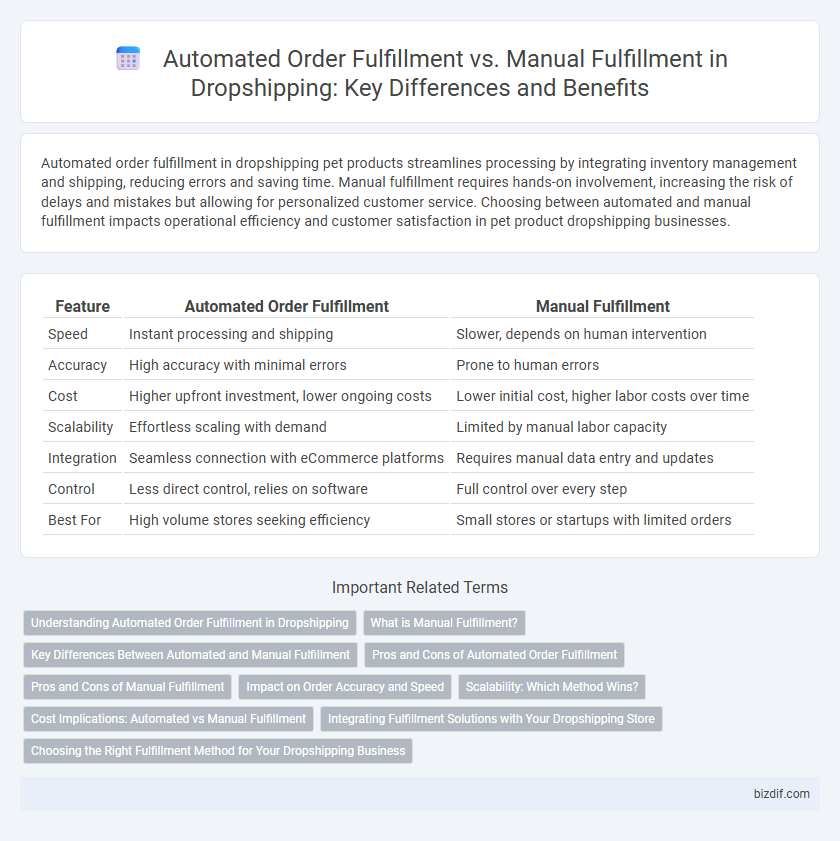Automated order fulfillment in dropshipping pet products streamlines processing by integrating inventory management and shipping, reducing errors and saving time. Manual fulfillment requires hands-on involvement, increasing the risk of delays and mistakes but allowing for personalized customer service. Choosing between automated and manual fulfillment impacts operational efficiency and customer satisfaction in pet product dropshipping businesses.
Table of Comparison
| Feature | Automated Order Fulfillment | Manual Fulfillment |
|---|---|---|
| Speed | Instant processing and shipping | Slower, depends on human intervention |
| Accuracy | High accuracy with minimal errors | Prone to human errors |
| Cost | Higher upfront investment, lower ongoing costs | Lower initial cost, higher labor costs over time |
| Scalability | Effortless scaling with demand | Limited by manual labor capacity |
| Integration | Seamless connection with eCommerce platforms | Requires manual data entry and updates |
| Control | Less direct control, relies on software | Full control over every step |
| Best For | High volume stores seeking efficiency | Small stores or startups with limited orders |
Understanding Automated Order Fulfillment in Dropshipping
Automated order fulfillment in dropshipping streamlines the process by integrating e-commerce platforms with suppliers to instantly process and ship orders without manual intervention. This system reduces errors, saves time, and enhances customer satisfaction through faster delivery and real-time tracking updates. Utilizing automated fulfillment tools like Oberlo or DSers can significantly improve operational efficiency and scalability for dropshipping businesses.
What is Manual Fulfillment?
Manual fulfillment in dropshipping involves processing and handling orders by hand, including tasks such as verifying order details, updating inventory, and coordinating shipments with suppliers. This approach requires more time and effort compared to automated systems but allows for greater control and customization in order management. Merchants using manual fulfillment often benefit from direct oversight of each transaction, which can improve accuracy for complex or unique products.
Key Differences Between Automated and Manual Fulfillment
Automated order fulfillment leverages technology such as software integration, barcode scanning, and real-time inventory management to speed up processing and reduce human error, while manual fulfillment relies on human labor for picking, packing, and shipping products. Automated systems provide scalability and higher accuracy, especially useful for high-volume dropshipping stores, whereas manual fulfillment offers more flexibility for customized orders and smaller operations. The key differences lie in processing speed, error rates, scalability, and the required labor intensity.
Pros and Cons of Automated Order Fulfillment
Automated order fulfillment in dropshipping streamlines processing by reducing human error and accelerating shipment times, enhancing customer satisfaction and operational efficiency. However, it requires upfront investment in technology and may lack flexibility to address unique order issues or last-minute changes. Merchants should weigh these benefits and drawbacks based on order volume and customization needs to optimize fulfillment strategies.
Pros and Cons of Manual Fulfillment
Manual fulfillment in dropshipping offers precise control over order processing and customization, which can enhance customer satisfaction and reduce errors during packaging and shipping. However, it demands significant time and labor, slowing down scalability and increasing the risk of human error in inventory management compared to automated systems. Businesses using manual fulfillment must carefully balance the need for personalized service against the limitations in efficiency and resource allocation.
Impact on Order Accuracy and Speed
Automated order fulfillment in dropshipping significantly improves order accuracy by reducing human error through real-time inventory updates and automated data entry processes. It also accelerates shipping speed by instantly processing orders and coordinating with suppliers without manual intervention. Manual fulfillment often results in slower processing times and a higher risk of errors due to manual data handling and delayed communication.
Scalability: Which Method Wins?
Automated order fulfillment significantly outperforms manual fulfillment in scalability by streamlining inventory management, order processing, and shipping integrations through advanced software solutions. This automation reduces human error, accelerates order turnaround times, and easily handles large volumes during peak seasons without additional labor costs. Conversely, manual fulfillment struggles with increased order complexity and volume, limiting growth potential and operational efficiency for expanding dropshipping businesses.
Cost Implications: Automated vs Manual Fulfillment
Automated order fulfillment significantly reduces labor costs by minimizing manual data entry and processing errors, leading to faster shipping times and improved customer satisfaction. Manual fulfillment incurs higher operational expenses due to increased staffing needs and greater risk of order inaccuracies, which can result in costly returns and customer service issues. Investing in automated systems often yields long-term cost savings despite initial setup expenses, optimizing overall dropshipping profitability.
Integrating Fulfillment Solutions with Your Dropshipping Store
Integrating automated order fulfillment solutions with your dropshipping store streamlines the entire process by reducing manual errors and speeding up order processing times. Automated systems seamlessly connect with your e-commerce platform, enabling real-time inventory updates and order tracking that enhance customer satisfaction. Manual fulfillment requires constant oversight and is prone to delays, making automated integration essential for scaling and maintaining efficiency in dropshipping operations.
Choosing the Right Fulfillment Method for Your Dropshipping Business
Automated order fulfillment streamlines dropshipping operations by reducing errors and accelerating shipment times, crucial for maintaining customer satisfaction and scaling your business efficiently. Manual fulfillment offers greater control and flexibility for niche products or when managing smaller inventories, allowing personalized quality checks that automated systems may miss. Evaluating order volume, budget constraints, and the complexity of your product catalog helps determine the optimal fulfillment method to enhance reliability and profitability.
Automated Order Fulfillment vs Manual Fulfillment Infographic

 bizdif.com
bizdif.com